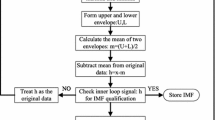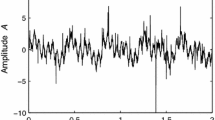Abstract
The present paper proposes a novel denoising method to suppress multi-source noise and enhance the signal-to-noise ratio (SNR) of the phase-sensitive optical-time-domain reflectometer (Ф-OTDR). The method is based on complete ensemble empirical mode decomposition with adaptive noise (CEEMDAN) and the interval thresholding. Firstly, the CEEMDAN is applied to the vibration signals to obtain a series of functions called the Intrinsic Mode Functions (IMFs). Secondly, the trip point is determined according to the fact that the product of energy density of the IMF and its corresponding averaged period is a constant. Then, the IMFs of noise dominant mode are treated with interval thresholding, and finally the IMFs and residual are reconstructed to obtain denoised signals. The results show that the SNR of disturbance location increases to 51.21 dB and 52.11 dB respectively, which represents a great improvement when compared with the other two methods.







Similar content being viewed by others
References
Z. Yan, L. Shuqin, L. Sheng et al., Study of pattern recognition based on multi-characteristic parameters for φ-OTDR distributed optical fiber sensing system. Chin. J. Lasers 42(11), 1105005 (2015)
A. Minardo, A. Coscetta, G. Porcaro et al., Structural health monitoring in the railway field by fiber-optic sensors. Lect. Notes Electr. Eng. 319, 359–363 (2015)
H. Meng, F. Liu, D.D. Zhao, Application of distributed acoustic sensor technology in train running condition monitoring of the heavy-haul railway. Optik 181, 343–350 (2019)
J. Tejedor, J. Macias-Guarasa, H.F. Martins et al., Real field deployment of a smart fiber optic surveillance system for pipeline integrity threat detection: architectural issues and blind field test results. J. Lightwave Technol. 36(4), 1052–1062 (2018)
M. Li, X.L. Xiong, Y.F. Zhao et al., Denoising method based upon ECEMD and selective addition for phi-OTDR. Opt. Commun. 452, 313–320 (2019)
M. Yonas, Recent advances in distributed acoustic sensing based on phase-sensitive optical time domain reflectometry. J. Sens. 2018, 1–16 (2018)
M. Adeel, C. Shang, K. Zhu et al., Nuisance alarm reduction: using a correlation based algorithm above differential signals in direct detected phase-OTDR systems. Opt. Express 27(5), 7685–7698 (2019)
H.F. Taylor, C.E. Lee. Apparatus and method for fiber optic intrusion sensing: US, US 5194847[P]. 1993.
Y. Lu, T. Zhu, L. Chen et al., Distributed vibration sensor based on coherent detection of phase-OTDR. J. Lightwave Technol. 28(22), 3243–3249 (2010)
Z. Qin, L. Chen, X. Bao, Wavelet denoising method for improving detection performance of distributed vibration sensor. IEEE Photon. Technol. Lett. 24(7), 542–544 (2012)
Z. Qin, H. Chen, J. Chang, Signal-to-noise ratio enhancement based on empirical mode decomposition in phase-sensitive optical time domain reflectometry systems. Sensors 17(8), 1870 (2017)
N.E. Huang, S. Zheng, S.R. Long et al., The empirical mode decomposition and the Hilbert spectrum for nonlinear and non-stationary time series analysis. Proc. Math. Phys. Eng. Sci. 1998(454), 903–995 (1971)
Z. Wu, Ensemble empirical mode decomposition: a noise assisted data analysis method. Adv. Adapt. Data Anal. 1(1), 1–41 (2009)
Z. Wu, N.E. Huang, X. Chen, The multi-dimensional ensemble empirical mode decomposition method. Adv. Adapt. Data Anal. 1(3), 339–372 (2009)
M.E. Torres, M.A. Colominas, G. Schlotthauer, et al. A complete ensemble empirical mode decomposition with adaptive noise. Proceedings of the IEEE International Conference on Acoustics, Speech, and Signal Processing, ICASSP 2011.
M.A. Colominas, G. Schlotthauer, M.E. Torres et al., Noise-assisted EMD methods in action. Adv. Adapt. Data Anal. 4(4), 1250025 (2012)
M.A. Colominas, G. Schlotthauer, M.E. Torres, Improved complete ensemble EMD: a suitable tool for biomedical signal processing. Biomed. Signal Process. Control 14, 19–29 (2014)
H. Wu, S. Xiao, X. Li et al., Separation and determination of the disturbing signals in phase-sensitive optical time domain reflectometry (Φ-OTDR). J. Lightwave Technol. 33(15), 3156–3162 (2015)
Y. Qiu, Z. Qin, X. Xiong et al., Vehicle vibration detection Φ-OTDR system design and signal processing. Opt. Commun. Technol. 4, 33–36 (2018)
Y. Kopsinis, S. Mclaughlin, Development of EMD-based denoising methods inspired by wavelet thresholding. IEEE Trans. Signal Process. 57(4), 1351–1362 (2009)
Y. Kopsinis, S. McLaughlin. Empirical mode decomposition based denoising techniques. 1st International work-shop on cognitive information processing (CIP2008), 2008.
A.O. Boudraa, J.C. Cexus, EMD-based signal filtering. IEEE Trans. Instrum. Meas. 56(6), 2196–2202 (2007)
L. Tang, G. Chen, H. Wu, Penetration deceleration signal processing method with ensemble empirical mode decomposition and consecutive mean square error. Chin. J. High Press. Phys. 32(5), 055104 (2018)
Q. Lu, L.X. Pang, H.Q. Huang et al., High-G calibration denoising method for high-G MEMS accelerometer based on EMD and wavelet threshold. Micromachines 10(2), 134 (2019)
Z. Wu, N.E. Huang, A study of the characteristics of white noise using the empirical mode decomposition method. Proc. R. Soc. A Math. Phys. Eng. Sci. 460(2046), 1597–1611 (2004)
Acknowledgements
This work was supported by the National Key R&D Program of China under Grant No. 2016YFB1200100.
Author information
Authors and Affiliations
Corresponding author
Additional information
Publisher's Note
Springer Nature remains neutral with regard to jurisdictional claims in published maps and institutional affiliations.
Rights and permissions
About this article
Cite this article
He, M., Feng, L. & Zhao, D. A method to enhance SNR based on CEEMDAN and the interval thresholding in Φ_OTDR systems. Appl. Phys. B 126, 97 (2020). https://doi.org/10.1007/s00340-020-07448-x
Received:
Accepted:
Published:
DOI: https://doi.org/10.1007/s00340-020-07448-x




